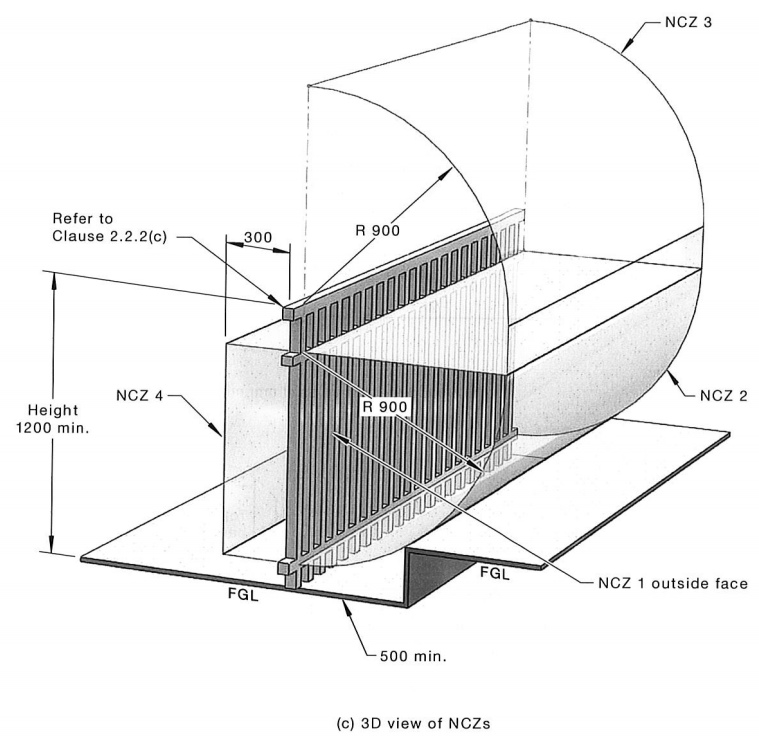Information
-
Location
-
Conducted on
-
Prepared by
-
Others present:
CPR signage:
-
Is there a warning notice (CPR Chart) erected?<br>Act s17
-
Please photograph the sign.
-
Is the sign in a prominent position in the immediate vicinity of the swimming pool?<br>Act s17(1)
-
Is the sign clearly legible?<br>Reg. Cl 11(b)
-
Is the sign legible from 3 metres?<br>Reg Cl 11(a)
-
Does the signage contain:
-
The words:<br>"YOUNG CHILDREN SHOULD BE SUPERVISED WHEN USING THIS SWIMMING POOL", and<br>"POOL GATES MUST BE KEPT CLOSED AT ALL TIMES", and<br>"KEEP ARTICLES, OBJECTS AND STRUCTURES AT LEAST 900MM CLEAR OF THE POOL FENCE AT ALL TIMES"<br><br>Reg. Cl 10(1)(a)
-
Details of resuscitation techniques for infants, children and adults?<br>Reg. Cl 10(1)(b)
-
Drawings with key words in bold print?<br>Reg. Cl 10(1)(b)(iii)
-
A statement that formal instruction in resuscitation is essential?<br>Reg. Cl 10(1)(c)
-
Is there a simple flow sequence for CPR?<br>Reg. Cl 10(1)(b)
-
The name of organisation that published the sign?<br>Reg. Cl 10(1)(d)
Access Restriction
-
How is access to the spa pool restricted?<br>
-
Is the spa pool covered and secured by a lockable, child-safe structure (such as a door, lid, grille or mesh)?
-
Is the door, lid, grille or mesh of substantial construction and having no opening through which it is possible to pass a testing apparatus?<br>Note: A testing apparatus is a cylindrical test object having a diameter of 105mm (+\- 1mm), and having at least one solid flat-faced end.<br>
-
Is the door, lid, grille or mesh fastened to the spa pool by a device that is itself of substantial construction and having no opening through which it is possible to pass a testing apparatus?<br><br>Note: A testing apparatus is a cylindrical test object having a diameter of 105mm (+\- 1mm), and having at least one solid flat-faced end.
-
Does the barrier separate the pool from any residential building or place adjoining the premises?<br>Act s7(1)(a)
-
Note: Residential building is defined by the Act:
"residential building means a building (such as a dwelling-house, residential flat building or boarding-house) that is solely or principally used for residential purposes, and includes any structure (such as a garage or shed) that is ancillary to any such building, but does not include:
(a) a building that merely forms part of a complex of buildings (such as a school or recreational centre) that is principally used for non-residential purposes, or
(b) a moveable dwelling, or
(b1) tourist and visitor accommodation, or
(c) a shed that is ancillary to a swimming pool and the primary purpose of which is to store equipment that is used in connection with the swimming pool (but not a shed of a kind prescribed by the regulations), or
(d) a building or structure of a kind prescribed by the regulations." -
WINDOWS opening into pool area restricted?<br><br>If sill is <1800 from ground, window must be either:<br>covered by bars or metal screen. Openings in bars or screen must not be >100mm and must require the use of a tool to remove<br>OR<br>Fixed so it cannot be opened any more than 100mm without the use of a tool<br><br>As1926.1-2012 s2.6
-
Is the barrier a permanent structure?<br>As1926.1-2012 s2.1
-
Is the barrier in a good state of repair as an effective and safe child-resistant barrier?<br>Act s15(1)
-
No features or objects that would reduce the height of the barrier to be located within 500mm of the barrier.<br>As1926.1-2012 s2.3.1
-
Features diagram
-
Is finished ground level a permanent stable surface?<br>As1926.1-2012 s1.3.6
-
Is the height of fence from top of fence to finished ground >1200mm (for non-boundary fence)?<br>As1926.1-2012 s2.1
-
Is the width of all vertical gaps <100mm?<br>As1926.1-2012 s2.3.6
-
Is the gap between bottom of barrier and finished ground level no greater than 100mm?<br>As1926.1-2012 s2.3.7
-
3D NCZ DIAGRAM
-
NCZ1 clear?<br>NCZ1 is measured vertically on outside face of barrier.<br>No handholds or footholds, or objects or plants that will facilitate climbing in NCZ.<br>No projections or indentations with horizontal surface >10mm.<br>As1926.1-2012 s2.2.2(a)
-
NCZ2 clear?<br>NCZ2 is a quadrant measured the outside of the barrier created by 900mm radius down from the top of NCZ1.<br>No handholds or footholds, or objects or plants that will facilitate climbing in NCZ.<br><br>Note: NCZ2 is always immediately adjacent to NCZ1 on all barriers<br>As1926.1-2012 s2.2.2(b)
-
NCZ3 clear?<br>NCZ3 is a quadrant on the outside of barrier created by a 900mm radius UP from the top of the barrier<br>No handholds or footholds, or objects or plants that will facilitate climbing<br><br>Note: If the top of NCZ1 is below the top of the barrier, NCZ3 extends vertically down to the top of NCZ1.<br>Note: NCZ3 does not apply to any item or component on, or that is part of, the barrier. NCZ3 is applicable only to the space created by the quadrant.<br>As1926.1-2012 s2.2.2(c)
-
NCZ4 clear?<br>NCZ4 is a 900mm high by 300mm deep rectangular space on the inside of the barrier, aligning with NCZ1.<br>No handholds or footholds, or objects or plants that will facilitate climbing in the NCZ.<br><br>Note: Only applies where barrier has vertical openings 10mm - 100mm in width.<br><br>As1926.1-2012 s2.2.2(d)
-
Boundary Pool Barrier
-
NCZ5 diagram
-
NCZ5 clear?<br>NCZ5 is a quadrant of 900mm radius, measured down from the top of the inside of the boundary pool barrier<br>No handholds or footholds, or objects or plants that will facilitate climbing in NCZ.<br>As1926.1-2012 s2.2.4(a)
-
No less than 1800mm, measured from inside the pool area?<br>As1926.1-2012 s2.2.4
-
Where internal pool barrier intersects into NCZ5, the top of internal barrier must: <br><br>- be less than 50mm and intersect at angle between 45 and 13 degrees,<br><br>OR<br><br>- continue at >1800mm for at least 900mm.<br>As1926.1-2012 s2.2.4(b)
-
Gates
-
Is the gate kept securely closed?<br>Act s16
-
Does gate swing away from pool area?<br>As1926.1-2012 s2.4.1.1
-
Does gate swing freely through its entire arc of operation? (i.e. cannot be wedged open)<br>As1926.1-2012 s2.4.1.1
-
Full arc of operation clear of any building or doorway?<br>As1926.1-2012 s2.4.1.1
-
Confirm overall height >1200mm (on outside of pool area)?<br>As1926.1-2012 s2.1
-
NCZs clear?
-
NCZ1?<br>As1926.1-2012 2.2.2(a)
-
NCZ2?<br>As1926.1-2012 s2.2.2(b)
-
NCZ3?<br>As1926.1-2012 s2.2.2(c)
-
NCZ4?<br>As1926.1-2012 s2.2.2(d)
-
Maximum 100mm under closed gate?<br>AS1926.1-2012 s2.4.1.1
-
Vertical spaces no more than 100mm?<br>AS1926.1-2012 s2.3.6
-
Self-closing device closes he gate from any position, with a stationary start, without the application of a manual force and operates the latch?<br> latch<br>2. From approximately half-open<br>3. From fully open position<br>4. Apply 25kg weight to gate whilst open for 30 seconds. Remove weight and let gate close under own propulsion.<br><br>AS1926.1-2012 s2.4.1.2
-
From gate resting on latch position?<br>AS1926.1-2012 s2.4.1.2
-
From partially open positions?<br>AS1926.1-2012 s2.4.1.2
-
From fully open position?<br>AS1926.1-2012 s2.4.1.2
-
From any position after a 25kg weight has been placed on the top rail or component, 100mm from the outer edge of the locking stile of the gate for 30 seconds and then removed?<br>AS1926.1-2012 s3.4
-
Lift gate upwards and pull downwards with a force of 250N.<br>The above movement of the gate must not:<br>1. Release the latch<br>2. unhinge the gate<br>3. increase gap under gate to >100mm<br><br>AS1926.1-2012 s2.4.1.3
-
Was a force gauge used to measure force applied?
-
Latch shall not be able to:<br>1. be inadvertently adjusted during operation<br>2. Locked in the 'open' position<br>3. adjusted without use of tools<br>AS1926.1-2012 s2.4.2.1
-
Release point for latch?<br>Either:<br>- No less than 1500mm from finished ground level,<br>(AS1926.1-2012 s2.4.2.2)<br>OR<br>- On inside and protected by 450mm shield, so no gaps >10mm present.<br>(AS1926.1-2012 s2.4.2.3)
-
Conduct strength and rigidity checks to vertical openings - apply 150N. 105mm diameter metal cone should not be able to pass through opening.<br>AS1926.1-2012 s3.1 & Appendix A
-
Was a forge gauge or similar measuring device used?
-
Conduct strength and rigidity checks to posts and footings - apply 330N of force at 1200mm height - no damage or loosening?<br>AS1926.1-2012 s3.2
-
Was a forge gauge or similar measuring device used?
-
Conduct strength and rigidity to rails/horizontals - apply 330N of force - no deformation or breakage?<br>AS1926.1-2012 s3.3
-
Was a forge gauge or similar measuring device used?
Overview
-
I have taken photographs of any non-compliance in the relevant sections.
-
Take photographs showing the general condition of the barrier here
-
Sketch if required
-
Additional Comments
-
Is there a significant risk to public safety?
-
Section 23A(1) of the NSW Swimming Pools Act 1992 (as in force at time of writing) allows the Council to carry out some or all of the requirements of a direction it has given if the Council considers that the requirements of the direction need to be carried out urgently as there is a significant risk to public safety.
-
What is the nature of the risk to public safety?
-
Is the safety of a person at risk?
-
If Council considers that the safety of a person is at risk if the requirements of a direction were not carried out as soon as possible, it may serve the direction without notice. See section 23(6) of the Swimming Pools Act 1992.
-
What is the nature of the risk?












